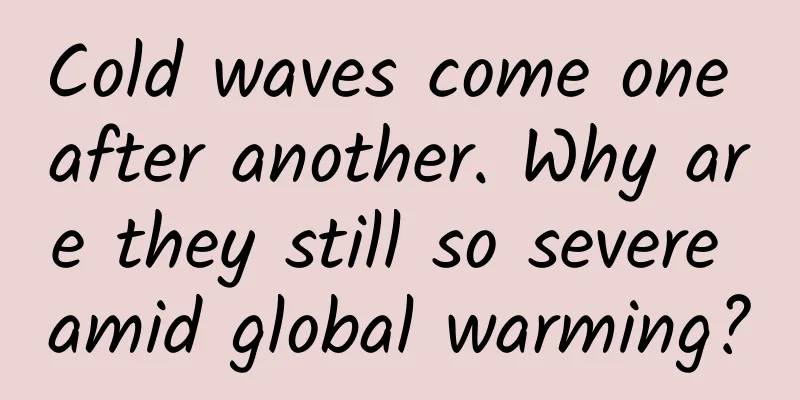Cold waves come one after another. Why are they still so severe amid global warming?

|
On November 30, the Central Meteorological Observatory continued to issue cold wave warnings. This is the fourth round of large-scale cold wave weather affecting my country since October this year. It is expected that from 8:00 on November 30 to 8:00 on December 1, the temperature in the southeastern part of Northeast China, Huanghuai, Jianghuai, central and eastern Jiangnan, and northeastern South China will drop by 6℃ to 8℃, and the temperature in some places may drop by 10℃ to 12℃. Some time ago, my country experienced three rounds of large-scale cold wave weather processes. After this cold wave process, another cold air will affect my country from December 2 to 3. Why are cold waves still so frequent and fierce in the context of global warming? The number of cold waves is higher than the same period Not counting the current round of cold waves that are having an impact, according to statistics from the National Climate Center, my country has experienced three rounds of large-scale cold wave weather processes since the second half of this year, occurring from October 14 to 17, November 4 to 8, and November 20 to 23. The first round of cold wave had a slightly weaker impact; the second round of cold wave was fierce, with large-scale snowstorms hitting the Northeast and precipitation in many places exceeding the November extreme value; the third round of cold wave had a large drop in temperature and a wide range of rain and snow. Although the intensity was slightly weaker, the regional superposition and cumulative effect was obvious. Monthly cold wave statistics from 1951 to 2020 show that, on average, there were 2 cold waves by the end of November in previous years, but there have been 4 this year, which is indeed more than the same period. However, the data also shows that November is the month with the most cold waves, followed by October and March. There were 4 cold waves in November 1990, and 3 in November 1979 and 2011. Image source: China Meteorological Administration Cold waves usually occur during the transition period of seasons, because the temperature drop is an important criterion for measuring whether the cold air reaches the level of a cold wave. In November and March, during the transition period of seasons, the temperature is falling or rising, and the fluctuations of cold air and basic temperature are large, which makes it relatively easy to meet the cold wave standards. Although cold waves occur frequently, as of November 28, the temperature in many places in central and eastern China is still warmer than usual. According to the current forecast, the cold air will weaken in early December, and the warmer situation in most parts of the country, especially in the north, may continue. Cold waves are generally decreasing but becoming more extreme Although there are more cold waves this winter, data show that the number of cold waves affecting my country is generally decreasing under the background of global warming. There were only two cold waves affecting my country in 1951, 1984 and 1985, while there were eight in 2009. Therefore, the decrease in cold waves is an average state, which does not mean that there are fewer cold waves in recent years than in the past. Image source: China Meteorological Administration Although the number of cold waves has decreased overall, the magnitude of abnormal weather and climate is increasing. The Arctic cold air may be more strongly disturbed, so it is not ruled out that more extreme cold waves will occur in certain regions and at certain times. Generally speaking, the cold air in the polar regions will be controlled by the Earth's westerly belt, which will keep it within a certain range. Although it often moves to lower latitudes, the westerly belt has a strong control, just like a "sheep pen". Under normal circumstances, the cold air "sheep" will be kept in the polar regions by the westerly belt. Under the combined effects of global warming and the polar amplification effect, the Arctic region has warmed significantly, the temperature gradient in mid- and high-latitudes has decreased, and the westerly winds over the Eurasian continent have weakened. As a result, the "sheep pen" of the westerly belt is no longer as solid as before, and the cold air trapped in the poles is more likely to break through the westerly belt and "leak down" to the south. Image source: China Meteorological Administration On the one hand, cold air is more likely to invade southward, and on the other hand, the strengthening of the meridional circulation pattern in the mid-latitudes is more conducive to the southward movement of polar or high-latitude cold air masses. In this case, the polar cold air masses can even directly enter my country's northeastern region, causing severe weather such as large-scale cold waves and blizzards in the north, and can further advance southward to bring large-scale cooling to my country's central and eastern regions, such as the super cold wave that broke temperature records in many places in the north from January 5 to 8 this year. Therefore, experts point out that global warming and cold waves are not contradictory. On the contrary, more extreme cold waves are more likely to occur under the background of global warming. In addition, global warming will not lead to warmer winters in all places. In some places in the northern hemisphere, it will make winters colder. This year is a "double La Nina year", and the cold air activities affecting my country in winter are frequent and strong. At present, the center of the cold vortex located in the Arctic Pole tends to lean towards the Eastern Hemisphere. Therefore, the number of cold waves may further increase from January to February next year. Image source: China Meteorological Administration Why are extreme cold and extreme warm occurring so frequently this year? In the westerly belt, the atmosphere moves in a wave-like manner, with the low troughs of the waves being low-pressure troughs and the high peaks being high-pressure ridges. Generally speaking, the areas controlled by high-pressure ridges are dominated by sinking air currents, with mostly clear weather; the areas in front of low-pressure troughs are dominated by rising air currents, combined with water vapor, with frequent rain and snow. These trough-ridge activities have been going on in various regions of the middle and high latitudes of the Northern Hemisphere. As the trough-ridge moves, cold and heat occur simultaneously, but in different places. In North America, Europe and Asia, the affected areas will experience "sunrise in the east and rain in the west", with warming and cooling occurring alternately, and sometimes showing a certain periodic regularity. Image source: China Meteorological Administration At a time when extreme weather is frequent, the activity of the trough and ridge in the westerly belt is more likely to experience large fluctuations and large amplitudes, which is manifested in the continuous occurrence of extreme conditions of severe cold or warmth. Although the cold wave from January 5 to 8 this year caused many places in the north to set new records for the lowest temperatures since meteorological records were kept, the north saw a significant rebound in February, with many places setting new records for the warmest temperatures during the same period. Image source: China Weather Network The north-south span of the westerly belt trough ridge is unusually large this year. From late June to July, there are four strong high-pressure ridge centers in the westerly belt circulation in the Northern Hemisphere, respectively over Europe, the Russian Far East, western North America and the northern Atlantic Ocean, and high temperature heat waves have occurred in the corresponding regions. This cold and warm is not only reflected in the temperature, it also indirectly affects other extreme weather events. In mid-July, the westerly high pressure ridge continued to be strong, blocking the Mediterranean cyclone system from moving north, causing continuous heavy rainfall in Europe, triggering floods and causing casualties in Germany and other places. In addition, the multiple tornado events that occurred in my country in June this year also reflected the fierce confrontation between warm and humid air currents and cold air, which occurred against the background of great warmth; the extreme heavy rain in Henan in July also showed warm performance, and the abundant warm and humid water vapor made it possible to break the record rainfall. Reporter: Huang Yao |
<<: "White light" suddenly appeared in many places in Henan. What is it?
Recommend
Can't stop eating melon seeds? Your melon seed addiction is not entirely your fault!
Melon seeds, as the well-deserved king of nationa...
At what degree of myopia will there be a risk of blindness?
One minute with the doctor, the postures are cons...
6 common monetization methods on Zhihu
First of all, everyone should know that Zhihu, as...
If you learn physics well, you can make the most delicious fried rice...right?
When I was a child, my deskmate Xiaohua asked me:...
Why did LeEco, which raised 16.8 billion yuan, still fight with suppliers who wanted to collect debts?
"LeEco has reached its daily limit, please h...
What are the functions of the Guangzhou office leasing mini program? How much does it cost to develop a rental app?
Nowadays, many companies choose to rent an office...
Private domain traffic cannot save the brand!
The concept of private domain traffic is said to ...
[Case] 18 methods of social marketing of Durex!
How to judge whether something is really popular?...
My feet stink when it's hot. Is it athlete's foot? The answer is unexpected →
"Your feet smell terrible, you must have ath...
1080P is eliminated: How long will it take for 4K to become fully popular?
In recent years, the electronic display market is...
A complete guide to writing PR articles for APP promotion, 90% of good operators know...
"The successful APP soft article marketing a...
Analysis of B Station's product and user growth
The article provides a brief analysis of Bilibili...
Is the Douyin live broadcast room unpopular? A detailed explanation of how to generate traffic in Douyin’s live broadcast room!
"I have put in advertising, but the populari...
Brand marketing promotion: How to create a hit brand?
Introduction: Good brands try their best to meet ...
Seven paradigms for programmers to post on WeChat Moments
[[222966]] The photo of Jack Ma and 13 top scient...









